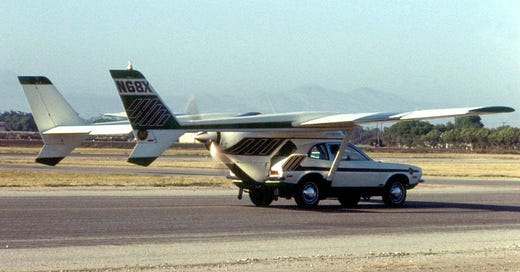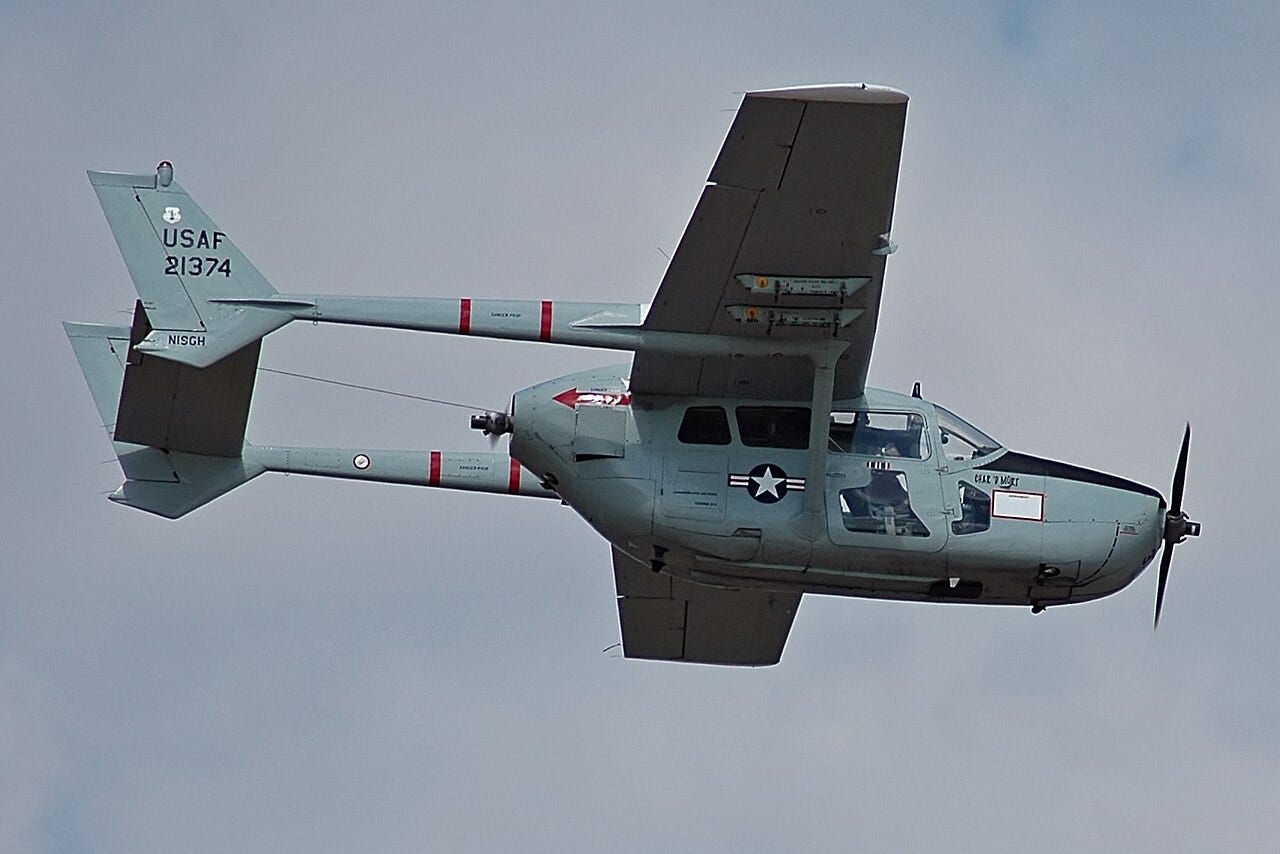For decades, Americans have dreamed of a flying car. It’s not so much a solution in search of a problem as a problem in search of a more complex and dangerous problem.
Pause for a moment and think about those happy-go-lucky, resourceful, and stable people you encounter during your commute. Now, think about them moving in three dimensions without speed limits or lanes, “driving” flying cars in various states of repair. Take a deep, calming, yoga breath (DCYB) and try to loosen your grip on your phone or tablet before you deform the plastic.
Enter Henry Smolinski and Harold Blake, two aerospace engineers who, in 1970, founded Advanced Vehicle Engineers in Van Nuys, CA. The company had one purpose: to develop a flying car. They created the AVE Mizar, a Frankenstein combination of a Ford Pinto and a 337 Cessna Skymaster, which came as close to commercial success as any company so far.
The Pinto was Ford’s first subcompact car. It had a reputation for catching fire if it was hit from behind, even at low speeds, due to the car’s fuel tank design. While this flaw is somewhat controversial, several deadly fires occurred when the tanks ruptured. In 1978, Ford was forced to recall 1971-76 Pintos for fuel-tank modifications.
To be fair to Smolinski and Blake, the bad news about the Pinto didn’t become common knowledge until 1977 when an article in Mother Jones magazine titled Pinto Madness appeared. Plus, according to a 1970 Associated Press article, they originally planned to use a Pontiac. They did not mention a specific model—maybe the Gran Prix. The Firebird seems like poor branding.
The Skymaster was a novel twin-engine airplane with its engines in a push-pull configuration: one engine and propeller at the front of the cabin and the other behind it. The plane had twin tail booms to make room for the rear propeller. Since both engines were along the plane's centerline, controlling it if one engine failed was much easier.
In theory, it was a simple series of modifications: remove the front engine and cabin from the Skymaster, insert and securely fasten the Pinto, and connect the rear engine and control surfaces.
The user would drive to the airport, attach the wings/engine, and fly off. Once they reached their destination, they would land at an airport, remove the wings/engine, put down the kickstand, and drive off in the car for their holiday or business travels.
Cut an airplane in half, get rid of one engine, and strap a car with a reputation for catching fire to it; what could go wrong?
The company estimated the price range for the flying Pinto to be from $18,300 to $29,000, roughly $127,900 to $202,690 in today’s money. I know what you’re thinking: potential buyers could have just spent the money on airline tickets and rental cars. Not only would it be safer, but they wouldn’t have to drive around in a Pinto.
Another option would have been buying a single-engine airplane like the Cessna 172 Skyhawk, driving their current car to the airport, and renting a car at their destination.
One also wonders about the $10,000 price range. Did the sports model have a moon roof, leather upholstery, undercoating, spinner hubcaps, and tinted windows?
Beanfields and Broken Wings
That just left the minor problem of getting this contraption into the sky and back again. The Mizar could use both the car and aircraft engines during launch to shorten the takeoff roll. Once airborne, the Mizar was expected to have a cruising speed of 130 mph, a range of 1,000 miles, and a ceiling of 12,000 feet.
On Sunday, August 26, 1973, Test pilot Charles "Red" Janisse took the Mizar up for a test flight from the Oxnard, CA, airport. Soon after takeoff, the right-wing strut base mounting attachment failed. Janisse realized that turning the plane was the wrong move since it might put too much stress on the unsupported wing, so he landed in a bean field. After the road was closed to traffic, he drove the flying car back to the airport. The plane was repaired, and its 210 hp engine was replaced with a 300 hp unit.
On Tuesday, September 11, 1973, Janisse was unavailable, so Smolinski and Blake conducted some ground taxi tests and then unexpectedly decided to take the flying Pinto up themselves. Smolinski was a private pilot.
From the Sunday, September 23, 1973, El Paso Times:
“On its last flight, however, the mated car-plane reached an altitude of approximately 400 feet. As it entered a left turn, the pilot requested permission for an emergency landing, and almost simultaneously, the plane was seen breaking up. Witnesses said it looked like the car separated from the wings. At any rate, the Mizar crashed into a truck and burst into flames. No one was injured on the ground, according to reports.”
Janisse surmised that the wing folded because Smolinski tried to turn the plane after the wing strut support failed. Smolinski and Blake died in the crash.
The NTSB report categorized the incident as an airframe failure in flight and noted the following in its remarks: The aircraft/Pinto car combined right wing strut attach fitting failed at the auto body. Damaged other car ( a pickup truck) and trailer.
Pop Culture
In the 1974 James Bond film The Man with the Golden Gun, the villain, Francisco Scaramanga, escapes at the end of a car chase by driving his AMC Matador into a building, attaching wings, a jet engine, and a tail boom to it, and flying off.
The filmmakers achieved this effect by filming a miniature model of the car/plane flying off. The AVE Miza is believed to have inspired this plot point.
The 1988 war film Bat*21 prominently featured the Cessna O-2 Skymaster, the military version of the 337 Cessna Skymaster.
If you enjoyed this article, please consider sharing it with a friend. Comments always welcome. If you have a bad idea you’d like me to write about, message me. You can find my historical crime coverage at blueridgetruecrime.com. I also write on medium.com.
Sources
Mother Jones September/October Issue 1977: Pinto Madness by Mark Dowie
Berkshire Eagle, Pittsfield, MA, Monday, August 03, 1970, “age 17, “Engineer Plans to Leave Earth in a Pontiac”
Ventura County Star, CA, Thursday, September 13, 1973, Page 10, “Flying Pinto Death Flight Pilot’s Impulse”
El Paso Times, TX, Sunday, September 23, 1973, Page 21, “Another Dream Ends in Tragedy”
Mental Floss: The Flying Pinto That Killed Its Inventor







On August 23, 1973 as a 17 year old I had left Oxnard toward Camarillo in my 1949 Ford F-1 Pick up truck. I turned around to go home on W Pleasant Valley Rd passing by Camarillo Airport . I looked to my right and saw a 71 Ford Pinto flying above the runway about 50 feet or so in the air parallel to my truck. I looked at it several times because well you don't see a flying Ford Pinto very often. Before the end of the runway the road veers to the left heading to Oxnard so I never saw it reach the end of the runway or the touch down in the bean field. My memory was that there were a lot of celery field but there may have been other crops.
I just wanted to point out that it was Camarillo Airport and not Oxnard Airport. When I reported to my family and friends that I saw a Flying Pinto I took a good amount of ribbing. How do you prove in the days before computers or the internet that you saw something as fantastic as a flying Ford Pinto. Unfortunately two weeks later the owner and the engineer crashed and we read the story in the Oxnard Press Courier so I was vindicated but I would rather there were flying cars.